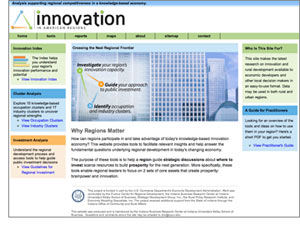Feature Article
Innovation in American Regions: Online Data and Tools for Economic Development Strategy & Decision Making
Special from EDA Grantees: Jerry Conover, Indiana University
& Sam Cordes, Purdue University
 The notion that economic development is most effectively pursued via regional, cluster-based efforts is central to contemporary practice and EDA's strategic focus. So is the idea that regions can prosper by cultivating innovation-driven growth strategies.
The notion that economic development is most effectively pursued via regional, cluster-based efforts is central to contemporary practice and EDA's strategic focus. So is the idea that regions can prosper by cultivating innovation-driven growth strategies.
These concepts underlie a rich, online resource developed with EDA support for use by economic development practitioners (EDPs), civic leaders and policymakers throughout the nation. The Innovation in American Regions website provides detailed, county-level data and a set of practical analytical tools regional leaders can use to assess their regions' industry clusters, human capital and capacity to innovate.
It also presents a practical framework for regional leaders to collaborate to achieve mutual regional development goals. Using the results of the analytical tools, the framework helps guide the discussions of regional leaders in selecting sound strategies and in identifying the united efforts required to achieve common goals.
Four Tools for EDPs
The Innovation website is constantly updated with the latest economic and demographic data, which may be viewed or downloaded for pre-established or user-defined regions ranging in size from one to many counties. The user may view the data in tables and graphs and download it for further analysis. Comparisons across regions are easily managed. Four types of tools designed with EDPs in mind are available on the site. These are:
- Industry clusters: regional groups of firms and industries with similar needs for technology, infrastructure, support services and labor. The site provides regional data for 17 industry clusters and several manufacturing sub-clusters.
- Occupation clusters: groupings of occupations requiring similar knowledge and skills. Understanding a region's occupation clusters is key to assessing how well its workforce matches the needs of its industries and the opportunity for growing existing or attracting new industries to capitalize on workforce capabilities. This tool provides county-level data on 15 occupation clusters.
- A newly developed Index of Innovation reflects a region's capacity to innovate and transform its economy. The Innovation Index helps assess a region's competitive advantages and weaknesses, and gauges how adept the region may be in growing new and emerging industries.
- A Regional Strategy and Investment Framework that uses the information gained from these three analytical tools to guide regional leaders toward a common regional vision, strategy and action.
The Innovation website also provides a practitioners guide with practical tips for using these tools, case study illustrations of the tools' application in four different regions, and hundreds of downloadable maps.
A Widely Used Resource
EDPs throughout the nation are finding Innovation in American Regions a useful resource to aid their work. This project and its tools received national awards of excellence from the Council on Community and Economic Research in 2010 and from the Association for University Business and Economic Research in 2009. The project is the result of a collaborative effort by the Purdue Center for Regional Development, the Indiana Business Research Center at Indiana University, Strategic Development Group Inc., Economic Modeling Systems Inc., and the Rural Policy Research Institute. For more information about the project and for guidance in using the tools, go to www.statsamerica.org/innovation.


